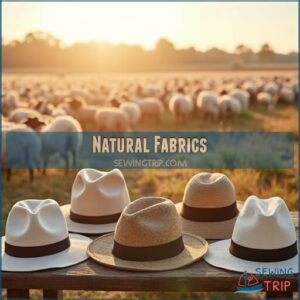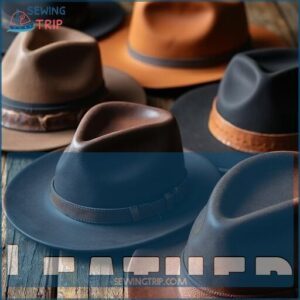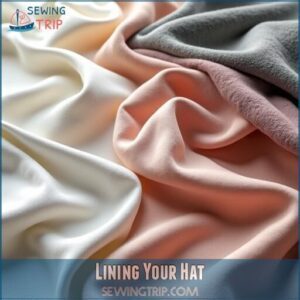This site is supported by our readers. We may earn a commission, at no cost to you, if you purchase through links.
 You’re on the hunt for the best fabric for hats, and it’s all about balance.
You’re on the hunt for the best fabric for hats, and it’s all about balance.
You want a material that’s breathable, moisture-wicking, and insulating.
Natural fabrics like cotton and wool are great options, while synthetic fabrics like polyester and nylon offer durability.
But what about specialized materials like straw or leather?
When choosing the best fabric for hats, consider your needs and preferences.
You’ll find that different fabrics work better for different hats, and understanding these differences is key to finding the perfect fit, which is exactly what you’ll discover next.
Table Of Contents
Key Takeaways
- Natural fabrics excel for comfort – You’ll get the best breathability and moisture-wicking with cotton, linen, and wool, which naturally regulate temperature and feel comfortable against your skin.
- Synthetic materials offer superior durability – You can rely on polyester and nylon for long-lasting hats that resist wear, maintain their shape, and handle tough conditions better than natural fibers.
- Match fabric to your specific needs – You should consider your climate, activity level, and style preferences when choosing between breathable summer materials like straw or insulating winter options like wool.
- Proper care extends hat lifespan – You’ll keep your hats looking great longer by using gentle cleaning techniques, storing them properly to maintain shape, and following fabric-specific maintenance guidelines.
Hat Fabric Considerations
When you’re choosing a hat, you consider factors like breathability, moisture control, and insulation to guarantee it’s comfortable and functional.
Choose a hat with breathability, moisture control, and insulation for ultimate comfort
You’ll want to think about how these factors impact your hat-wearing experience, and what types of fabrics will best meet your needs.
Breathability
Air circulation is the secret ingredient in any breathable hat fabric.
When you pick cotton or linen, these materials nail fabric ventilation and sweat evaporation, setting the stage for top-tier comfort levels.
Their cooling properties support thermoregulation, giving you a break from summer heat.
For peak airflow, look for hats with:
- Built-in ventilation
- Lightweight weave
- Quick-dry features
- Ample crown space, which aids in thermoregulation
Moisture Control
After breathability, moisture control is your best friend in warm weather.
A breathable hat fabric with solid sweat management—think polyester—delivers top-tier moisturewicking and quick drying.
Wool earns points for fabric absorbency and natural odor resistance, keeping sweat absorption high and musty smells low.
Prioritize climate control and moisture management in your choice to stay comfortable as temperatures rise.
Insulation
If you’ve ever wished your hat worked as a portable heater, insulation is the unsung hero behind fabric warmth.
Wool, a classic winter hat fabric, traps heat while allowing moisture to escape, making it ideal when temperatures drop.
Modern insulation materials, including thermoregulating synthetics, blend function and freedom, letting you brave the cold with confidence.
Always weigh climate impact and heat retention when picking your next cozy winter hat.
Popular Hat Fabrics
You’ll see hats made from cotton, wool, linen, straw, polyester, and nylon, each offering distinct technical properties for different needs.
Choosing the right fabric balances breathability, moisture control, and durability, so you won’t end up regretting your hat choice on a hot day or in sudden rain, considering factors like moisture control.
Natural Fabrics
Step into the domain of natural fabrics, where each weave tells a story of comfort and function.
Hungry for Linen Properties or the cozy embrace of Wool Benefits? Here’s what makes these classics shine:
- Linen cools you down with natural breathability and a silky touch.
- Cotton’s versatility means softness, moisture absorption, and hypoallergenic ease.
- Wool offers superior insulation plus moisture-wicking for chilly days.
- Choose straw for stylish sun hats with reliable UPF protection.
- Embrace fabric sustainability—linen and organic cotton show care for the planet.
To guarantee ethical sourcing, look for hats made with Responsible Wool Standard certified wool.
Synthetic Fabrics
Now that you know what natural fibers offer, let’s talk synthetics.
Polyester durability keeps your hat in shape through every hike, while nylon breathability makes it easy to wear even on hot days.
Acrylic benefits your winter hats, mimicking wool’s warmth without losing form.
Synthetic blends balance comfort and longevity—goodbye, droopy brims.
Plus, recycled synthetics and innovative polymer compositions mean you can look sharp and tread lighter.
Synthetic hats offer a diverse range of styles and textures developed in laboratories.
Synthetic fabrics work hard behind the scenes, making every adventure more comfortable.
Specialized Hat Materials
You’re looking for specialized hat materials that offer unique properties, such as straw and leather, which provide distinct textures and aesthetics.
As you consider these materials, you’ll find that they cater to diverse fashion preferences and offer a range of benefits, from durability to breathability.
Straw
Straw emerges as nature’s answer to summer headwear, combining breathability with sun protection that synthetic materials can’t match.
This plant-derived material transforms into sophisticated Panama hats and flexible raffia designs through traditional weaving techniques.
Consider these straw varieties for your next hat:
- Toquilla straw – Creates authentic Panama hats with exceptional breathability
- Raffia – Offers flexibility and packability for travel-friendly designs
- Toyo straw – Provides water-resistant synthetic alternative with natural appearance
- Seagrass – Delivers rustic charm with superior straw durability
- Abaca – Features banana plant fibers for structured, elegant silhouettes
Straw weaves determine both style and function. Tighter weaves boost straw UPF ratings, while looser patterns maximize airflow.
Quality straw sourcing guarantees your hat withstands seasons of wear. For those seeking straw alternatives, synthetic versions offer similar aesthetics with enhanced weather resistance.
The fabric for straw hats varies widely, but natural fibers consistently outperform synthetics in comfort and breathability. For example, cotton offers breathability unmatched by many synthetics.
Leather
You consider leather for its durability and breathability.
Leather hats offer a unique aesthetic, with properties like waterproof hat fabric.
Many appreciate leather hats durability.
| Leather Durability | Leather Aesthetics | Leather Breathability |
|---|---|---|
| High | Versatile | Good |
| Long-lasting | Elegant | Moderate |
| Resistant | Rugged | Low |
| Durable | Sophisticated | High |
| Strong | Timeless | Good |
Lining Your Hat
When choosing a hat lining, you’ll want to evaluate factors like breathability, moisture control, and insulation.
Lining materials such as silk, cotton, or fleece can enhance comfort factors.
For seasonal linings, opt for lightweight fabrics like satin or muslin in warmer months, and switch to fleece for colder weather.
Effective hat lining fabric should also provide sweat absorption and odor control.
By selecting the right lining, you can guarantee your hat is stylish and comfortable to wear.
For a breathable option, consider cupro lining benefits.
Look for lining materials that balance comfort, durability, and style to create the perfect hat for any occasion.
Caring for Your Hat
By taking the time to properly care for your hats, you’re ensuring they remain a staple in your wardrobe.
To keep them looking their best, try these tips:
- Use gentle Cleaning Techniques to avoid damaging the fabric
- Implement effective Stain Removal methods to prevent discoloration
- Utilize proper Storage Solutions to maintain the hat’s shape.
Regular fabric care and hat care instructions can help extend the life of your hats, and understanding fabric maintenance is key to keeping them in great condition, including hat storage and hat lining, as well as Reshaping Hats and Repair Methods.
To maintain your hat’s quality, consider using specialized cleaning products.
Frequently Asked Questions (FAQs)
What is the best fabric for hats?
You’ll find the best fabric for hats depends on factors like climate, activity, and style, with options ranging from breathable cotton and wool to durable polyester and straw.
What is the best fabric for a running hat?
You’ll want moisture-wicking fabrics like polyester or nylon for a running hat, as they keep you dry and comfortable during intense activities, making them ideal choices.
What is the best fiber for hats?
You’ll discover natural fibers like wool, cotton, and linen are ideal for hats, offering breathability, moisture-wicking, and durability, while synthetic fibers provide versatility and ease of care.
What is the most breathable material for hats?
You’ll find linen and cotton are the most breathable materials for hats, offering natural ventilation and moisture-wicking properties for ultimate comfort.
What fabrics work well for summer hats?
You’ll prefer breathable fabrics like cotton, linen, or straw for summer hats, offering comfort, moisture-wicking properties, and protection from the sun.
Are hats with UPF protection really effective?
You’ll be pleased to know that hats with UPF protection are indeed effective, blocking up to 99% of UV radiation, making them a great choice for outdoor activities.
Do hats made from recycled materials last?
You’ll be amazed, hats made from recycled materials can last incredibly long, offering durability and sustainability, while also reducing waste, making them a great eco-friendly choice for you.
Can I wear wool hats in warm weather?
You can wear wool hats in warm weather, but they might be too hot, as wool provides insulation and retains heat, making it more suitable for cooler climates naturally.
Are synthetic hats better for active people?
Thou seekest performance, so synthetic hats are better for you, offering moisture-wicking, durability, and breathability, making them ideal for active people in various weather conditions and outdoor activities.
Conclusion
Finding the best fabric for hats is a personal quest.
You weigh factors like breathability and moisture control.
Now, you’re equipped to choose the best fabric for hats, considering natural and synthetic options, and specialized materials like straw or leather, to find your perfect fit with the best fabric for hats.
- https://richardsonluxehats.com/blog/different-types-of-hat-materials-and-their-unique-benefits
- https://acmehatco.com/hat-fabrics/
- https://fabricmaterialguide.com/hat/the-impact-of-fabric-choice-on-hat-durability/
- https://www.rushordertees.com/blog/best-performance-hats/
- https://www.kbethos.com/blog/which-hat-materials-are-the-most-breathable












